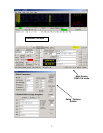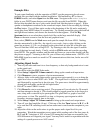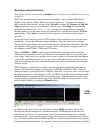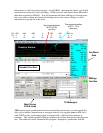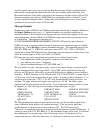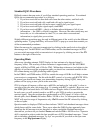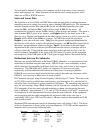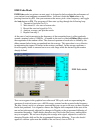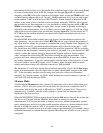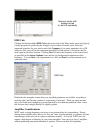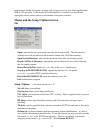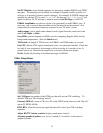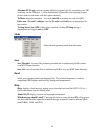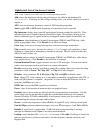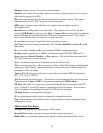Information in the text box gives the number N of completed echo cycles, the average Level
of receiver background noise in dB, the average echo strength Sig in dB, its measured
frequency offset DF in Hz (after correction for Doppler shift), its spectral Width in Hz, and
a relative quality indicator Q on a 0–10 scale. Background noise level is given with respect
to the nominal “0 dB” level used for all WSJT modes. Signal strength is measured in dB
relative to the noise power in the full receiver passband, nominally 2500 Hz. Q = 0 means
that an echo has not been detected or is very unreliable, in which case the values of DF and
Width are meaningless and Sig is an upper limit. Larger values of Q imply increasingly
believable echo measurements. If you can hear your own lunar echoes, you will see a large
spike in the red curve within a few seconds after toggling Auto ON. If your echoes are 15
to 20 dB below the audible threshold you should see a significant spike on the red curve
within a few minutes.
By default EME Echo mode assumes that your receiver and transmitter are tuned to the
same frequency. An on-screen box labeled RIT (Hz) allows you to inform the program of
any offset receiver tuning, for example to accommodate a large Doppler shift. Suppose you
are running a test on 23 cm and the predicted Doppler shift at the start of the run is –1400
Hz. In that case the 1500 Hz transmitted audio tone would be detected at 100 Hz, probably
well below the low-frequency cutoff in your receiver's passband. Use your transceiver's RIT
control to offset the receiver tuning by the predicted Doppler shift or a nearby rounded
value, and enter this offset in the RIT box before starting the echo measurement. The
program will track subsequent Doppler changes up to about 800 Hz, if necessary, without
any further adjustments. Your echo should appear near the center of the red curve, as usual.
You won't need to use the RIT feature on 6 or 2 meters, where Doppler shifts are much
smaller and echoes always fall within the transceiver's SSB passband.
The frequency of a valid echo should be well defined and stable. If you click Clear Avg to
start a new measurement, the echo signal (the red spike) should build up again at the same
DF. To be absolutely sure that you are seeing you own echo, offset your transmitter
frequency by a known amount, say 50 Hz, while holding the receiver frequency constant. A
valid echo will shift by the same 50 Hz.
Measure Mode
A button labeled Measure provides a means for measuring relative noise power from your
receiver. Click it and your system will record audio for one second, compute the level of
noise power, and display the result in dB relative to WSJT’s standard level. This cycle is
repeated every 2 seconds, with the results plotted as a green line and summary data
displayed in the large text box.
If the file DECODED.CUM has been activated from the File menu, data will be written into
that file as well, tagged with the Modified Julian Date on which you made the
measurements. You can use this mode to measure sun noise, antenna temperature, ground
noise, preamp gain, and a host of other useful quantities relative to a chosen reference level.
Be sure to disable the receiver AGC if you intend to use the mode for quantitative
measurements. It would also be wise to make some test measurements (for example, using a
calibrated attenuator) to confirm that the reported dB readings are reliable in your system as
configured.
10



